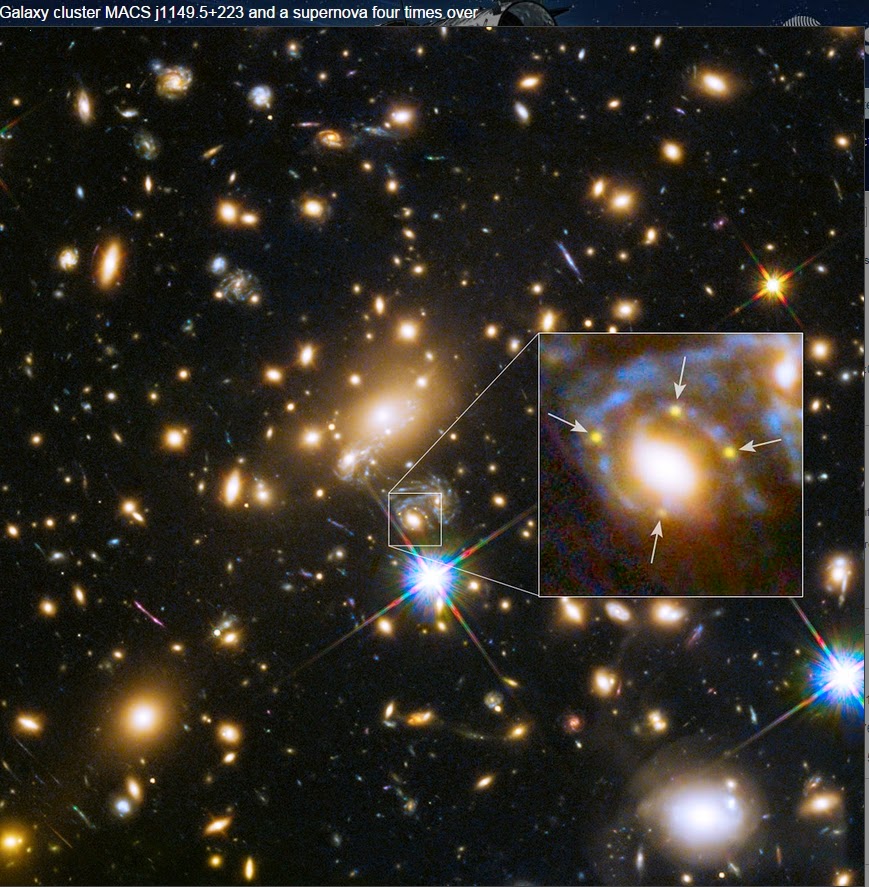Gravitational lensing creates an "Einstein Cross".
Apr 1, 2015 21:10:14 GMT
frankmcvey (Angel) and Gregg1956 like this
Post by Hill on Apr 1, 2015 21:10:14 GMT
The following is part of the text from a National Geographic website article ( news.nationalgeographic.com/news/2015/03/150305-supernova-lensing-einstein-cross-space/ ) describing an unusual event, multiple images of a supernova so far away we should not be able to see it. But because of gravitational lensing, we can.
"Exactly one century ago, in his theory of general relativity, Einstein described how massive objects could tug on light, and even pull at the fabric of space-time. Put simply, strong gravitational fields can act as lenses-warping, magnifying, and redirecting light as it travels through the cosmos. (See another supernova made superbright by gravitational lensing.)
"It's just this incredible verification of general relativity," says study co-author Ryan Foley of the University of Illinois at Urbana-Champaign. (Learn how a NASA gravity probe confirmed two more of Einstein's predictions.)
Depending on the lensing geometry and position of the viewer—in this case, the Hubble Space Telescope—multiple images of the same background object can be produced. Some of those images might even arrive years apart.
Here, one of the galaxies in a massive cluster five billion light-years away is acting as a lens for the dying star. The supernova's four projected images are arranged in a configuration known as an Einstein Cross—but they're not all playing at the same speed, because the light took slightly different paths on its way to Earth. Though a handful of bright, active galaxies have been caught in a cross shape before, this is the first supernova found in perfect quadruplicate."
I have made an overlay of this area in and located it the correct position in Google Sky. What is no more than a vague smudge in Sky's 2007 SDSS imagery becomes much more detailed in the HST imagery.

"Exactly one century ago, in his theory of general relativity, Einstein described how massive objects could tug on light, and even pull at the fabric of space-time. Put simply, strong gravitational fields can act as lenses-warping, magnifying, and redirecting light as it travels through the cosmos. (See another supernova made superbright by gravitational lensing.)
"It's just this incredible verification of general relativity," says study co-author Ryan Foley of the University of Illinois at Urbana-Champaign. (Learn how a NASA gravity probe confirmed two more of Einstein's predictions.)
Depending on the lensing geometry and position of the viewer—in this case, the Hubble Space Telescope—multiple images of the same background object can be produced. Some of those images might even arrive years apart.
Here, one of the galaxies in a massive cluster five billion light-years away is acting as a lens for the dying star. The supernova's four projected images are arranged in a configuration known as an Einstein Cross—but they're not all playing at the same speed, because the light took slightly different paths on its way to Earth. Though a handful of bright, active galaxies have been caught in a cross shape before, this is the first supernova found in perfect quadruplicate."
I have made an overlay of this area in and located it the correct position in Google Sky. What is no more than a vague smudge in Sky's 2007 SDSS imagery becomes much more detailed in the HST imagery.

PHOTOGRAPH BY NASA, ESA, AND T. TREU (UCLA), P. KELLY (UC BERKELEY) AND THE GLASS TEAM; S. RODNEY (JHU) AND THE FRONTIERSN TEAM;
J. LOTZ (STSCI) AND THE FRONTIER FIELDS TEAM; M. POSTMAN (STSCI), AND THE CLASH TEAM; AND Z. LEVAY (STSCI)
J. LOTZ (STSCI) AND THE FRONTIER FIELDS TEAM; M. POSTMAN (STSCI), AND THE CLASH TEAM; AND Z. LEVAY (STSCI)
